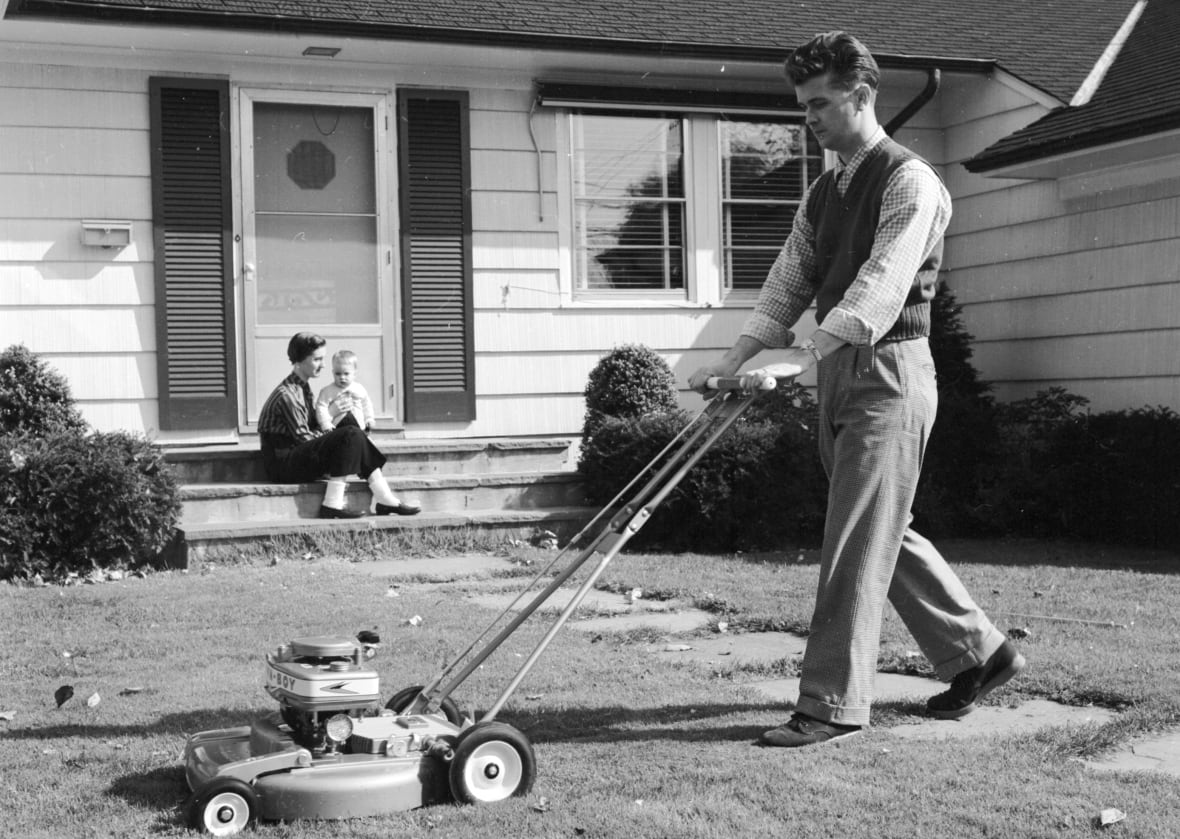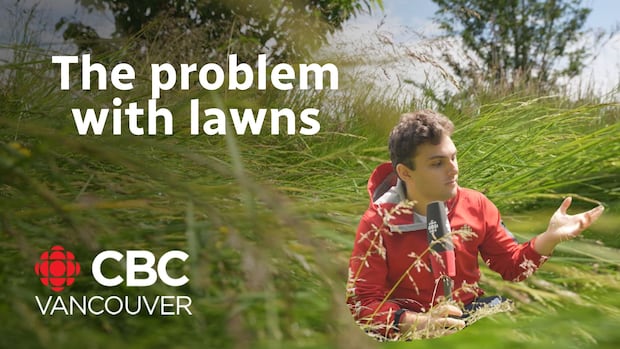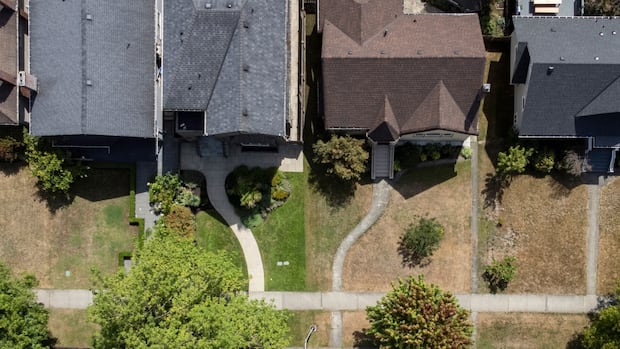As abnormally dry weather sweeps across much of the country this summer, you may have found yourself staring despondently at the brown, crispy patch of fried earth you once called your front lawn, felt your fingers twitch in the direction of the hose and wondered: Should I? Am I even allowed?
But environmental and horticultural experts, as well as proponents of the no-lawn movement, say the question is actually whether it’s responsible to have a full grass lawn at all anymore.
The David Suzuki Foundation has previously estimated there are about 6.2 million lawns across Canada, and calculated that anywhere from 8.2 to 22.7 per cent of several large Canadian municipalities are turf grass. In 2021, two-thirds of Canadian households reported they had a lawn, according to Statistics Canada.
These lawns are “biodiversity deserts,” according to the U.S. National Academy of Sciences, supporting very few insects and wildlife. They’re also notorious for their water waste and contribute to water scarcity. Maintaining them often involves harmful pesticides and fertilizers, while frequent mowing emits greenhouse gases.
And with many Canadian cities experiencing prolonged dry conditions, many lawns are looking … parched.
Enter the no-lawn, anti-lawn or re-wilding movement, a sustainable approach to landscaping and an attempt to shift our perspective on what yards can look like — and their purpose. This can include a naturalized yard, a habitat garden, using yards to grow food, or even just converting a section of your lawn to dedicate to native plant species and pollinators.
“There’s a crazy amount of lawn out there, like tens of millions of acres in Canada and the United States, dedicated to growing just turf grass,” said Brendon Samuels, a postdoctoral fellow with the Ecological Design Lab at Toronto Metropolitan University.
“Which is an imported, non-native group of species that has no real ecological value, that is very expensive to maintain and that doesn’t look so nice when you’re in the middle of a heat wave in the summer.”
WATCH | People are rethinking lawns: 
People are rethinking lawns amid a ‘cultural shift’
Brendon Samuels, a postdoctoral fellow with the Ecological Design Lab at Toronto Metropolitan University, says people are thinking more about individual actions they can take ‘in the midst of a biodiversity loss crisis that’s largely fuelled by habitat loss and land use planning.”Lawns should be area rugs’
Naturalized yards have a range of benefits, Samuels said, like helping preserve the monarch butterfly species by growing milkweed, or making one’s area more resilient to climate change with more green coverage.
Native plants help keep areas cooler and damper during heat waves, because they have deeper root systems that can access groundwater, he said. They also help increase the resilience of landscapes during floods, he added. And yes, you don’t need to water them as often as a turf grass lawn to keep them healthy, he said, making them more drought-resistant.
Brendon Samuels, a postdoctoral fellow with the Ecological Design Lab at Toronto Metropolitan University, has a naturalized yard, pictured here in London, Ont. (Brendon Samuels)
Last year, a study by the National Wildlife Federation found that 12 per cent of the U.S. adults surveyed said they were converting parts of their lawn to a natural or wildflower landscape.
The movement is particularly popular with a younger generation seeking out alternatives to grass, and is prominent on social media, notes Home and Garden magazine. And Garden Design magazine predicted that native plants and eco-friendly gardening will be the No. 1 gardening trend of 2025, followed by “less tidy” gardens.
On Pinterest, there are some 23,000 searches for “naturalistic garden.” Some videos on TikTok about growing native gardens have millions of views.
“We’re bringing messy back,” said Grant Minkhorst of Toronto, known as “Gardening Grant” on TikTok, in a video last month with 25,000 views where he shows off his thick vegetable beds, lunging perennial border and droopy prairie coneflowers.
“My measure of success is how much food did we produce? How many pollinators visited our gardens? That’s about it,” he added in the description.
And on Reddit, there are some 283,000 members of the “no lawns” subreddit, an online community devoted to “alternatives to monoculture lawns.” There, people there share photos of yards filled entirely with pink coneflowers and sprawling yellow coreopsis; leafy plants that climb over fences and fields of purple bee balm.
“As nature intended,” commented a Redditor on a video of someone’s sprawling, buzzing yard.
Samuels, left, plants his rainwater garden at his home in London, Ont. (Brendon Samuels)
The more we can stop being tidy, the more wildness we can bring into our gardens and landscapes, the better habitat we provide, said New York-based ecological horticulturist Rebecca McMackin in a 2023 Ted Talk video played more than 1.3 million times.
“Why not get rid of your lawn, or shrink it drastically?” she said. “Lawns should be area rugs, not wall-to-wall carpet.”
Have you ditched your grass for a naturalized lawn? Send us photos at ask@cbc.ca. The lawn as a status symbol
Lawns are a cultural import from 17th- and 18th-century Europe, where they were symbols of wealth and status, said Samuels — back then, you needed significant resources and labour to be able to maintain one.
“People default to the lawn because it’s very normative in our culture,” Samuels said.
“What we’re seeing increasingly is people starting to question those norms and look for alternatives.”
 A man mows his lawn in this 1956 archive photo. Lawns are a cultural import from 17th- and 18th-century Europe, where they were symbols of wealth and status. (Three Lions/Getty Images)
A man mows his lawn in this 1956 archive photo. Lawns are a cultural import from 17th- and 18th-century Europe, where they were symbols of wealth and status. (Three Lions/Getty Images)
That said, some people who have ditched the grass have faced hurdles. Lawn naturalization has been recognized as a constitutional right for decades in Canada, but bylaws haven’t always caught up, and The Associated Press notes that many homeowners’ associations still have rules about keeping yards manicured.
Samuels himself came up against bylaw when he created his own naturalized backyard and rainwater garden in London, Ont.
CBC News has previously covered cases in several cities across the country where people have come up against bylaw complaints about their natural yards — but also others where those bylaws have shifted to allow people to keep their yards as is.
Some cities, such as Toronto, offer grants for community-led projects to create pollinator gardens or convert a lawn area into one. Others offer exemptions to mowing height bylaws for residents who create naturalized areas.
And while some may assume naturalized yards would attract more pests, such as rodents or ticks, the opposite has been found to be true, according to a 2024 report by the Ecological Design Lab. And the David Suzuki Foundation explains that “simplified environments, like turfgrass lawns, favour white-footed mice, a key reservoir for Lyme disease in Canada.”
“A traditional lawn is one of the worst landscapes for wildlife — and one of the best for ticks.”
There’s a balance to be had here, Samuels said.
“We’re not going after anyone’s lawn,” he said. “But I think municipalities and individual property owners should be considering, ‘Do we need this much lawn?'”
WATCH | The problem with lawns: 
Why you should naturalize your lawn
With summer weather on the horizon, many British Columbians are starting to think about water conservation. Some experts say one of the best ways to do that is to naturalize lawns, allowing native plants and wildflowers to flourish. Darius Mahdavi headed out to the UBC Botanical Gardens to learn more.
This story has been updated to clarify attribution of the source of statements made about the ecological impact of some types of turf lawns.


Comments are closed.